Chemists behind Lego-like automated synthesis of complex organic molecules have unveiled the next generation of this technology, cutting cycle times down by an order of magnitude from 30 hours to just three. ‘To date, this approach has been limited because each carbon–carbon bond-forming step takes about a day,’ wrote the team led by Martin Burke at the University of Illinois at Urbana–Champaign.

Over the last decade, Burke’s group has pioneered this ‘snap-and-go’ approach to synthesis, weaving together complex organic structures using Suzuki–Miyaura cross-coupling reactions and N-methyliminodiacetic acid (Mida)-protected boron as the linchpin.
Burke’s Mida ligand was a game-changer, stabilising boronic acids traditionally prone to decomposition due to boron’s Lewis acidity. By altering boron’s hybridisation, Mida significantly reduced unwanted reactivity, enabling sequential Suzuki–Miyaura reactions for the first time under mild conditions.
The concept, says Burke, was born from a desire to level the playing field when it comes to molecular discovery. ‘There are 8 billion imaginations in the world but, at present, those that can meaningfully participate in the search for tomorrow’s medicines and materials represent just a fraction of a fraction of a fraction of this greatest natural resource,’ he says. ‘Automated iterative small molecule synthesis has the potential to democratise molecular innovation and thereby revolutionise the search for the undiscovered small tools that could transform our society.’
While Mida was revolutionary, a key limitation of the current platform is the long cycle time of more than one day per carbon–carbon bond-forming step resulting from the slow and variable kinetics of the Suzuki cross-coupling reaction. This is at least an order of magnitude slower than analogous, state-of-the-art peptide synthesisers widely used in the pharmaceutical industry.
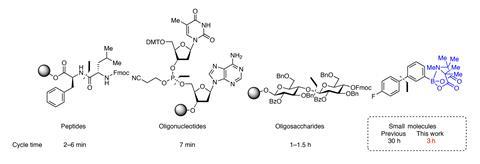
To bring their synthesiser up to speed, they reported a major overhaul to the platform in which ‘each step of the iterative cycle has been reimagined and re-optimised for speed, efficiency and generality’.
Alongside engineering optimisations, key to the synthesiser’s newfound success is tetramethyl-N-methyliminodiacetic acid (Tida) boronates developed by the Burke group in 2022. ‘Tida boronates are more than 1000 times more stable than their Mida boronate counterparts,’ explains Burke. This stability allows them to withstand reaction condition optimisations to the Suzuki–Miyaura coupling previously reported in the literature, which speeds up the reaction but is not tolerated by Mida boronates.
‘This system leverages [Tida’s] hyperstability,’ Burke adds, enabling the team to perform cross-couplings in just minutes and accelerating the rate by an order of magnitude per automated carbon–carbon bond-forming step.
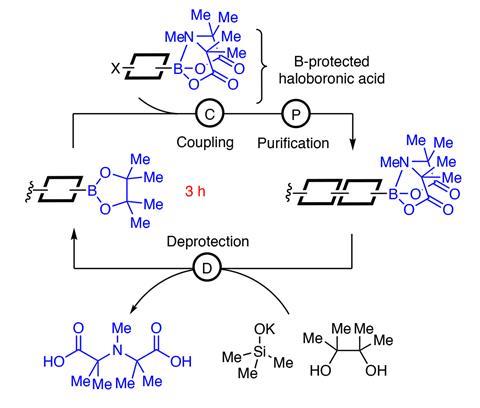
‘[This is] an impressive … change in efficiency in the automated synthesis of small molecules based on iterative cross couplings,’ comments Varinder Aggarwal at the University of Bristol who was not involved in the study. ‘It is currently limited to [Suzuki–Miyaura] couplings but once it can do other iterative C–C bond-forming reactions, it will be even more powerful.’
Whether this is significant enough for widespread adoption in the pharmaceutical industry remains to be seen. ‘I am convinced that it will be adopted over time, but there is always resistance to new technology,’ adds Aggarwal.
Burke also emphasises that this is not the last iteration of this technology. ‘Peptide and oligonucleotide synthesisers revolutionised science, medicine and technology, because their continued improvement was relentlessly improved.’
‘We are very inspired by this history and likewise plan to continue seeking relentless optimisation of this platform until the traditional synthesis bottleneck that currently limits access to small molecule innovation are shattered.’
References
W Wang et al, Nat. Synth., 2024, DOI: 10.1038/s44160-024-00558-w






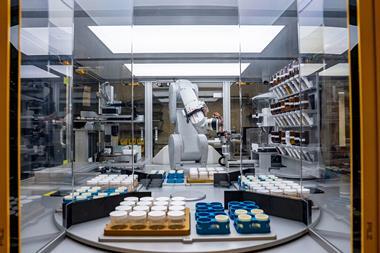

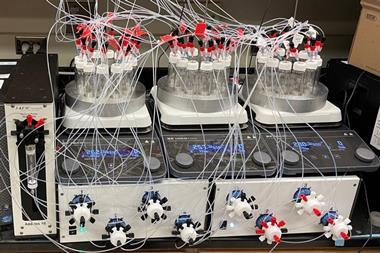
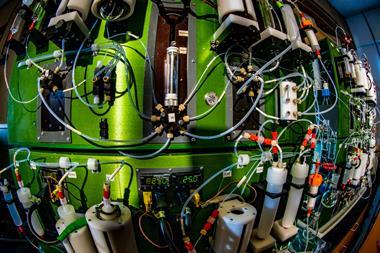







1 Reader's comment